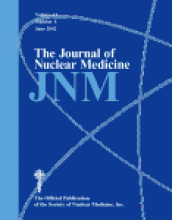Abstract
99mTc-Tetrofosmin is a recently introduced radioactive isotope for the assessment of myocardial perfusion. Data regarding the prognostic value of stress imaging using this isotope are scarce. The aim of this study was to assess the prognostic value of dobutamine-atropine 99mTc-tetrofosmin SPECT for the prediction of late cardiac events in patients with known or suspected coronary artery disease. Methods: A total of 721 consecutive patients with limited exercise capacity underwent dobutamine-atropine stress 99mTc-tetrofosmin SPECT. Follow-up was successful in 719 of 721 patients (99.7%). Twenty-eight patients who underwent early revascularization were excluded. Results: Myocardial perfusion abnormalities were detected in 381 patients (55%) and included fixed defects in 190 patients (27%) and reversible defects 191 patients (28%). During a mean follow-up period of 37 ± 17 mo, there were 150 deaths (22%), of which 62 (41%) were attributed to cardiac causes. Nonfatal myocardial infarction occurred in 23 patients (3%), and late (>3 mo) coronary revascularization was performed on 21 patients (3%). The cardiac death rate was 1%/y in patients with a normal scan and 5.1%/y in patients with an abnormal scan (P < 0.0001). In a multivariable Cox proportional-hazards model, the presence of abnormal perfusion was independently associated with an increased risk of cardiac death, after adjusting for clinical and stress test data (hazard ratio, 8.2; 95% confidence interval, 3.2–21). Conclusion: Dobutamine-atropine stress 99mTc-tetrofosmin SPECT is a useful imaging method for distinguishing patients at high and low risk of future cardiac events. The presence of perfusion abnormalities provides incremental prognostic information to clinical, stress electrocardiographic, and hemodynamic data.
Footnotes
Received Aug. 29, 2001; revision accepted Jan. 31, 2002.
For correspondence and reprints contact: Don Poldermans, MD, PhD, Department of Cardiology, Thoraxcenter, Room Ba 300, Erasmus Medical Center Rotterdam, Dr. Molewaterplein 40, 3015 GD Rotterdam, The Netherlands.
E-mail: poldermans{at}hlkd.azr.nl







